Business Strategy Analysis of Kellogg's Company: A Detailed Report
VerifiedAdded on 2020/01/15
|12
|3716
|161
Report
AI Summary
This report provides a comprehensive analysis of Kellogg's business strategy, examining its strategic position, choices, and actions. It begins with an introduction to business strategy, followed by an in-depth look at Kellogg's, including its mission, objectives, and SWOT analysis to understand its internal and external environments. The report then delves into strategic choices, focusing on corporate-level strategy and utilizing the Bowman strategy clock and Ansoff matrix to determine competitive advantages and growth strategies. Finally, the BCG matrix is employed to manage the product portfolio. The report concludes by outlining how these strategies translate into actionable steps for the company. The analysis covers market penetration, product development, and diversification strategies. The report highlights the importance of adapting to changing market dynamics and maintaining a strong competitive edge in the food industry.
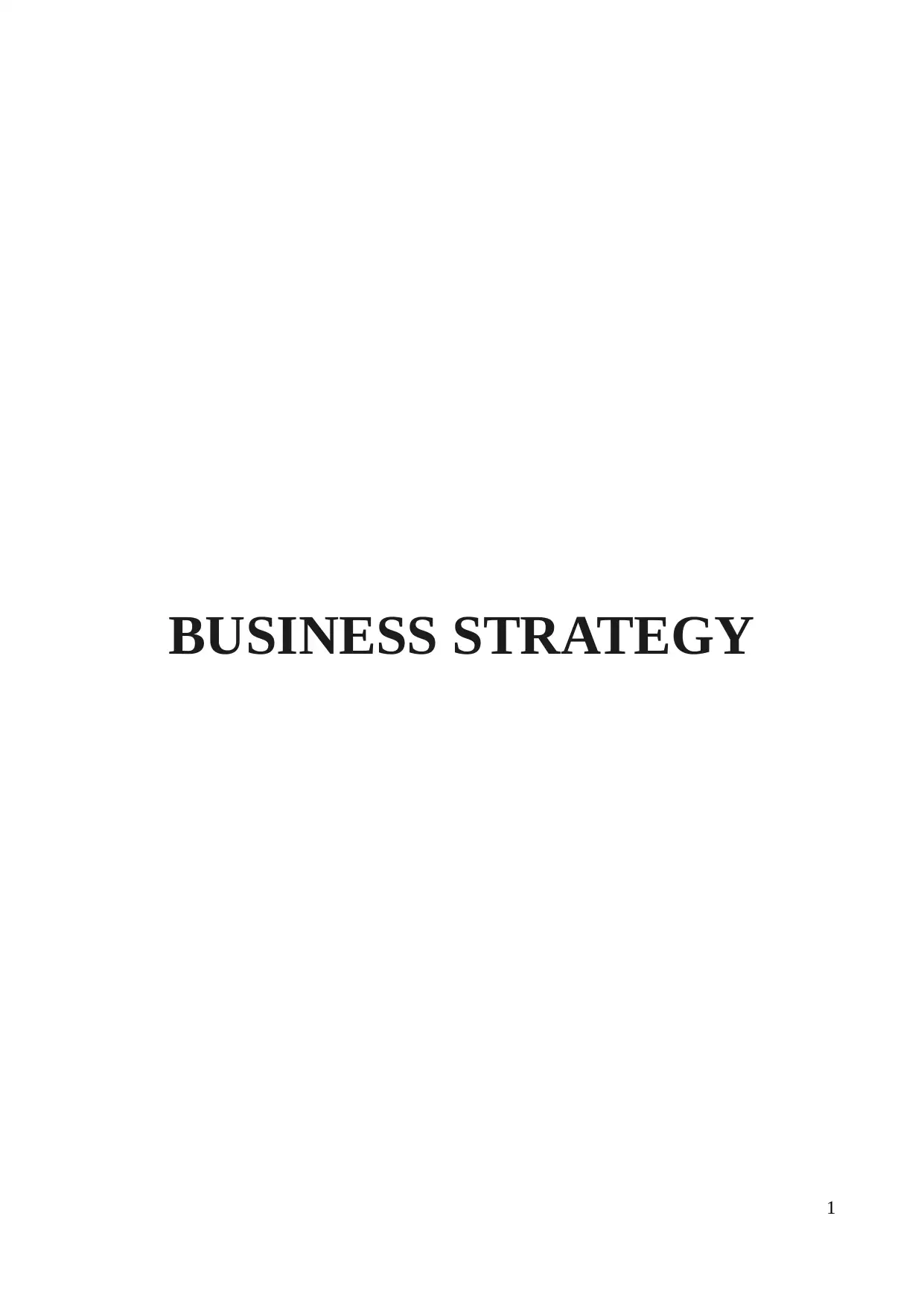
BUSINESS STRATEGY
1
1
Paraphrase This Document
Need a fresh take? Get an instant paraphrase of this document with our AI Paraphraser
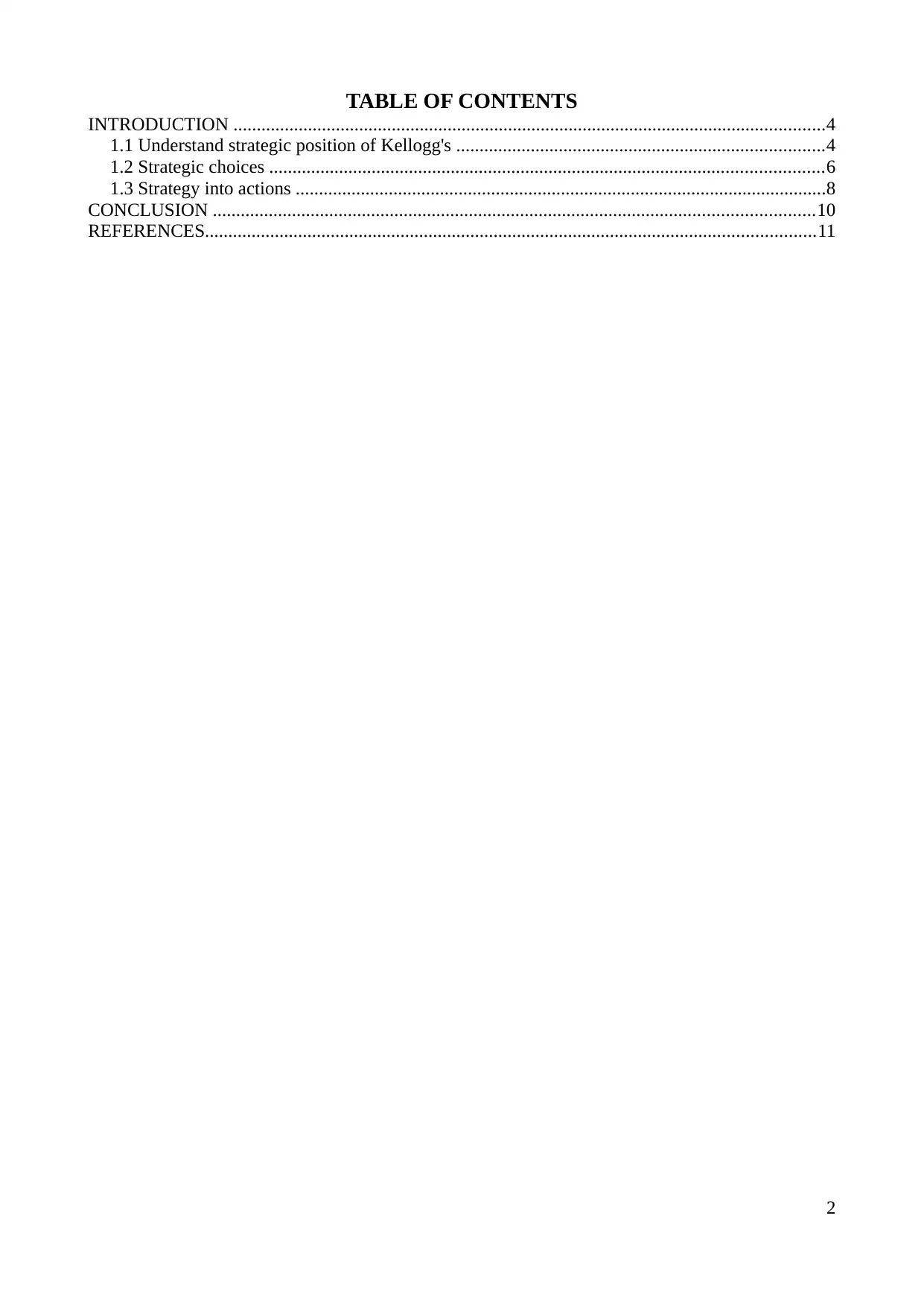
TABLE OF CONTENTS
INTRODUCTION ...............................................................................................................................4
1.1 Understand strategic position of Kellogg's ...............................................................................4
1.2 Strategic choices .......................................................................................................................6
1.3 Strategy into actions ..................................................................................................................8
CONCLUSION .................................................................................................................................10
REFERENCES...................................................................................................................................11
2
INTRODUCTION ...............................................................................................................................4
1.1 Understand strategic position of Kellogg's ...............................................................................4
1.2 Strategic choices .......................................................................................................................6
1.3 Strategy into actions ..................................................................................................................8
CONCLUSION .................................................................................................................................10
REFERENCES...................................................................................................................................11
2
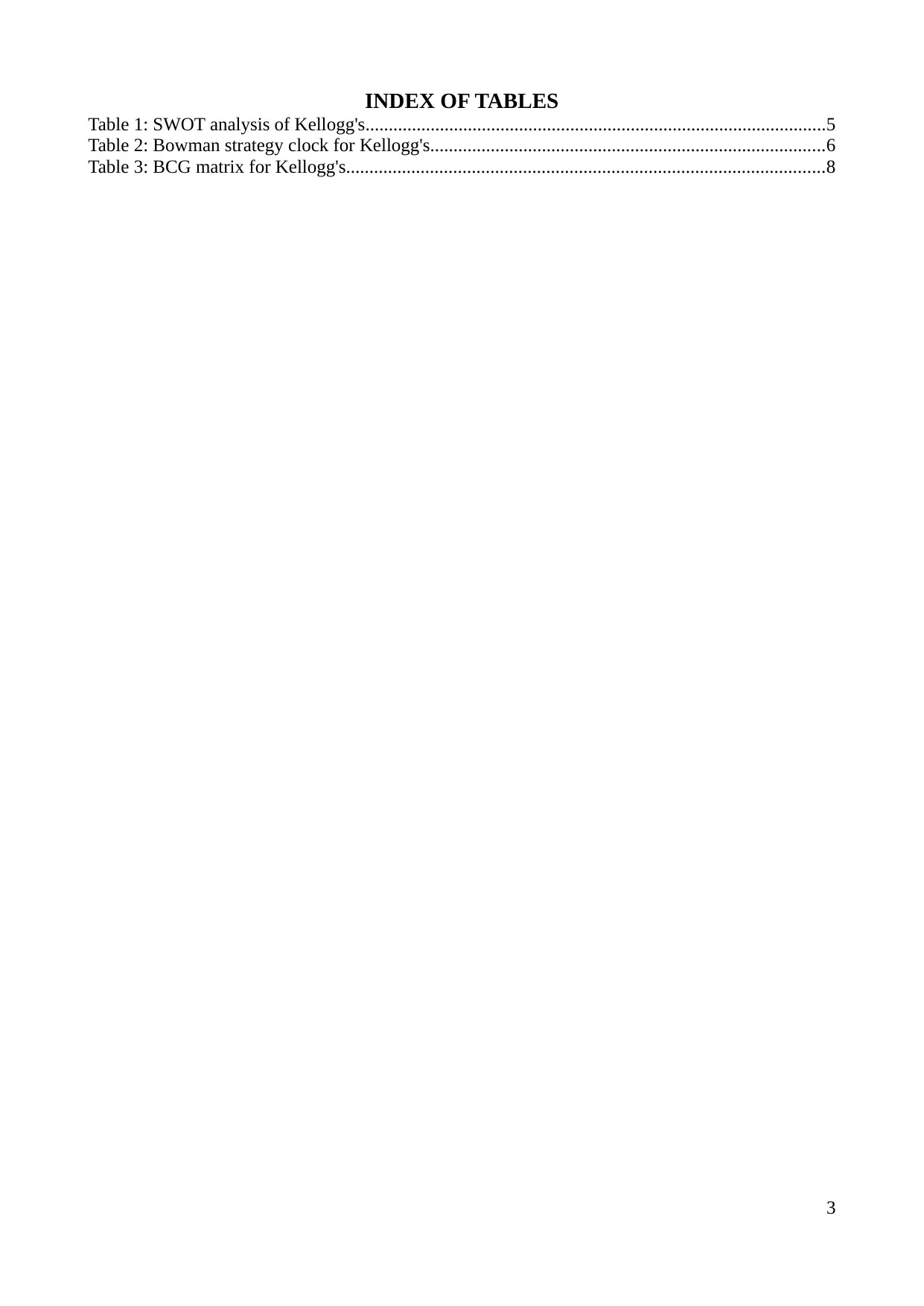
INDEX OF TABLES
Table 1: SWOT analysis of Kellogg's...................................................................................................5
Table 2: Bowman strategy clock for Kellogg's.....................................................................................6
Table 3: BCG matrix for Kellogg's.......................................................................................................8
3
Table 1: SWOT analysis of Kellogg's...................................................................................................5
Table 2: Bowman strategy clock for Kellogg's.....................................................................................6
Table 3: BCG matrix for Kellogg's.......................................................................................................8
3
⊘ This is a preview!⊘
Do you want full access?
Subscribe today to unlock all pages.

Trusted by 1+ million students worldwide
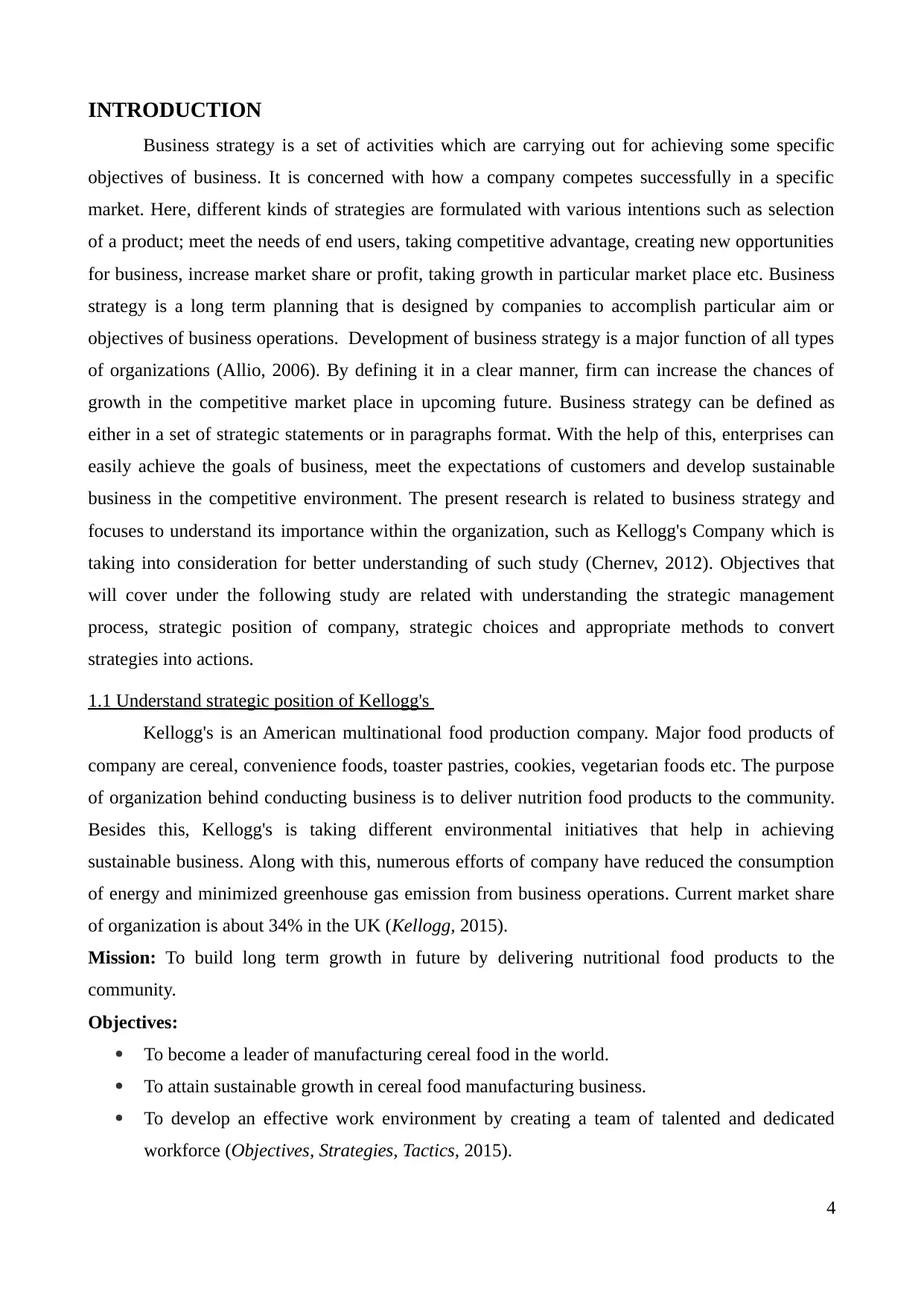
INTRODUCTION
Business strategy is a set of activities which are carrying out for achieving some specific
objectives of business. It is concerned with how a company competes successfully in a specific
market. Here, different kinds of strategies are formulated with various intentions such as selection
of a product; meet the needs of end users, taking competitive advantage, creating new opportunities
for business, increase market share or profit, taking growth in particular market place etc. Business
strategy is a long term planning that is designed by companies to accomplish particular aim or
objectives of business operations. Development of business strategy is a major function of all types
of organizations (Allio, 2006). By defining it in a clear manner, firm can increase the chances of
growth in the competitive market place in upcoming future. Business strategy can be defined as
either in a set of strategic statements or in paragraphs format. With the help of this, enterprises can
easily achieve the goals of business, meet the expectations of customers and develop sustainable
business in the competitive environment. The present research is related to business strategy and
focuses to understand its importance within the organization, such as Kellogg's Company which is
taking into consideration for better understanding of such study (Chernev, 2012). Objectives that
will cover under the following study are related with understanding the strategic management
process, strategic position of company, strategic choices and appropriate methods to convert
strategies into actions.
1.1 Understand strategic position of Kellogg's
Kellogg's is an American multinational food production company. Major food products of
company are cereal, convenience foods, toaster pastries, cookies, vegetarian foods etc. The purpose
of organization behind conducting business is to deliver nutrition food products to the community.
Besides this, Kellogg's is taking different environmental initiatives that help in achieving
sustainable business. Along with this, numerous efforts of company have reduced the consumption
of energy and minimized greenhouse gas emission from business operations. Current market share
of organization is about 34% in the UK (Kellogg, 2015).
Mission: To build long term growth in future by delivering nutritional food products to the
community.
Objectives:
To become a leader of manufacturing cereal food in the world.
To attain sustainable growth in cereal food manufacturing business.
To develop an effective work environment by creating a team of talented and dedicated
workforce (Objectives, Strategies, Tactics, 2015).
4
Business strategy is a set of activities which are carrying out for achieving some specific
objectives of business. It is concerned with how a company competes successfully in a specific
market. Here, different kinds of strategies are formulated with various intentions such as selection
of a product; meet the needs of end users, taking competitive advantage, creating new opportunities
for business, increase market share or profit, taking growth in particular market place etc. Business
strategy is a long term planning that is designed by companies to accomplish particular aim or
objectives of business operations. Development of business strategy is a major function of all types
of organizations (Allio, 2006). By defining it in a clear manner, firm can increase the chances of
growth in the competitive market place in upcoming future. Business strategy can be defined as
either in a set of strategic statements or in paragraphs format. With the help of this, enterprises can
easily achieve the goals of business, meet the expectations of customers and develop sustainable
business in the competitive environment. The present research is related to business strategy and
focuses to understand its importance within the organization, such as Kellogg's Company which is
taking into consideration for better understanding of such study (Chernev, 2012). Objectives that
will cover under the following study are related with understanding the strategic management
process, strategic position of company, strategic choices and appropriate methods to convert
strategies into actions.
1.1 Understand strategic position of Kellogg's
Kellogg's is an American multinational food production company. Major food products of
company are cereal, convenience foods, toaster pastries, cookies, vegetarian foods etc. The purpose
of organization behind conducting business is to deliver nutrition food products to the community.
Besides this, Kellogg's is taking different environmental initiatives that help in achieving
sustainable business. Along with this, numerous efforts of company have reduced the consumption
of energy and minimized greenhouse gas emission from business operations. Current market share
of organization is about 34% in the UK (Kellogg, 2015).
Mission: To build long term growth in future by delivering nutritional food products to the
community.
Objectives:
To become a leader of manufacturing cereal food in the world.
To attain sustainable growth in cereal food manufacturing business.
To develop an effective work environment by creating a team of talented and dedicated
workforce (Objectives, Strategies, Tactics, 2015).
4
Paraphrase This Document
Need a fresh take? Get an instant paraphrase of this document with our AI Paraphraser
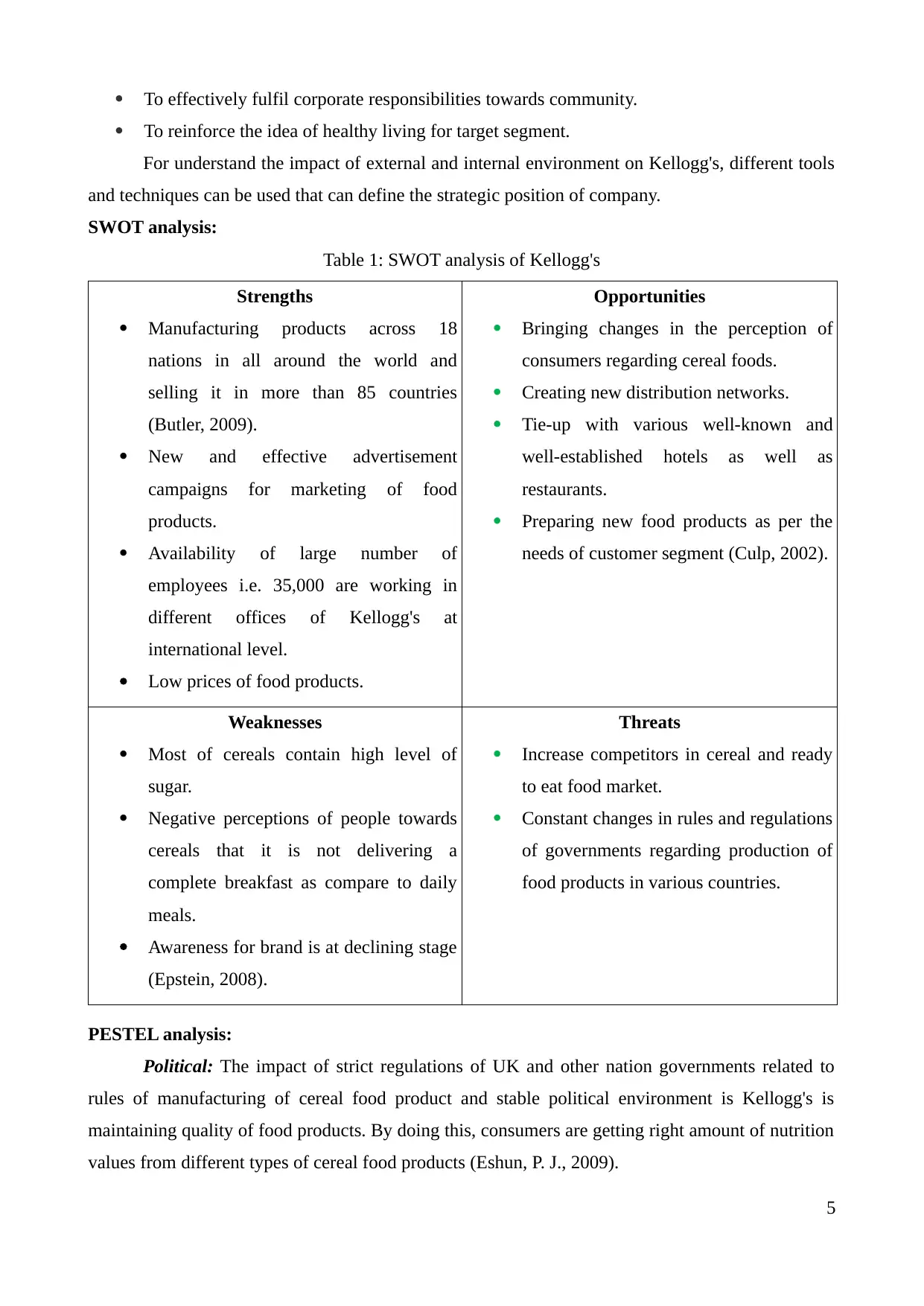
To effectively fulfil corporate responsibilities towards community.
To reinforce the idea of healthy living for target segment.
For understand the impact of external and internal environment on Kellogg's, different tools
and techniques can be used that can define the strategic position of company.
SWOT analysis:
Table 1: SWOT analysis of Kellogg's
Strengths
Manufacturing products across 18
nations in all around the world and
selling it in more than 85 countries
(Butler, 2009).
New and effective advertisement
campaigns for marketing of food
products.
Availability of large number of
employees i.e. 35,000 are working in
different offices of Kellogg's at
international level.
Low prices of food products.
Opportunities
Bringing changes in the perception of
consumers regarding cereal foods.
Creating new distribution networks.
Tie-up with various well-known and
well-established hotels as well as
restaurants.
Preparing new food products as per the
needs of customer segment (Culp, 2002).
Weaknesses
Most of cereals contain high level of
sugar.
Negative perceptions of people towards
cereals that it is not delivering a
complete breakfast as compare to daily
meals.
Awareness for brand is at declining stage
(Epstein, 2008).
Threats
Increase competitors in cereal and ready
to eat food market.
Constant changes in rules and regulations
of governments regarding production of
food products in various countries.
PESTEL analysis:
Political: The impact of strict regulations of UK and other nation governments related to
rules of manufacturing of cereal food product and stable political environment is Kellogg's is
maintaining quality of food products. By doing this, consumers are getting right amount of nutrition
values from different types of cereal food products (Eshun, P. J., 2009).
5
To reinforce the idea of healthy living for target segment.
For understand the impact of external and internal environment on Kellogg's, different tools
and techniques can be used that can define the strategic position of company.
SWOT analysis:
Table 1: SWOT analysis of Kellogg's
Strengths
Manufacturing products across 18
nations in all around the world and
selling it in more than 85 countries
(Butler, 2009).
New and effective advertisement
campaigns for marketing of food
products.
Availability of large number of
employees i.e. 35,000 are working in
different offices of Kellogg's at
international level.
Low prices of food products.
Opportunities
Bringing changes in the perception of
consumers regarding cereal foods.
Creating new distribution networks.
Tie-up with various well-known and
well-established hotels as well as
restaurants.
Preparing new food products as per the
needs of customer segment (Culp, 2002).
Weaknesses
Most of cereals contain high level of
sugar.
Negative perceptions of people towards
cereals that it is not delivering a
complete breakfast as compare to daily
meals.
Awareness for brand is at declining stage
(Epstein, 2008).
Threats
Increase competitors in cereal and ready
to eat food market.
Constant changes in rules and regulations
of governments regarding production of
food products in various countries.
PESTEL analysis:
Political: The impact of strict regulations of UK and other nation governments related to
rules of manufacturing of cereal food product and stable political environment is Kellogg's is
maintaining quality of food products. By doing this, consumers are getting right amount of nutrition
values from different types of cereal food products (Eshun, P. J., 2009).
5
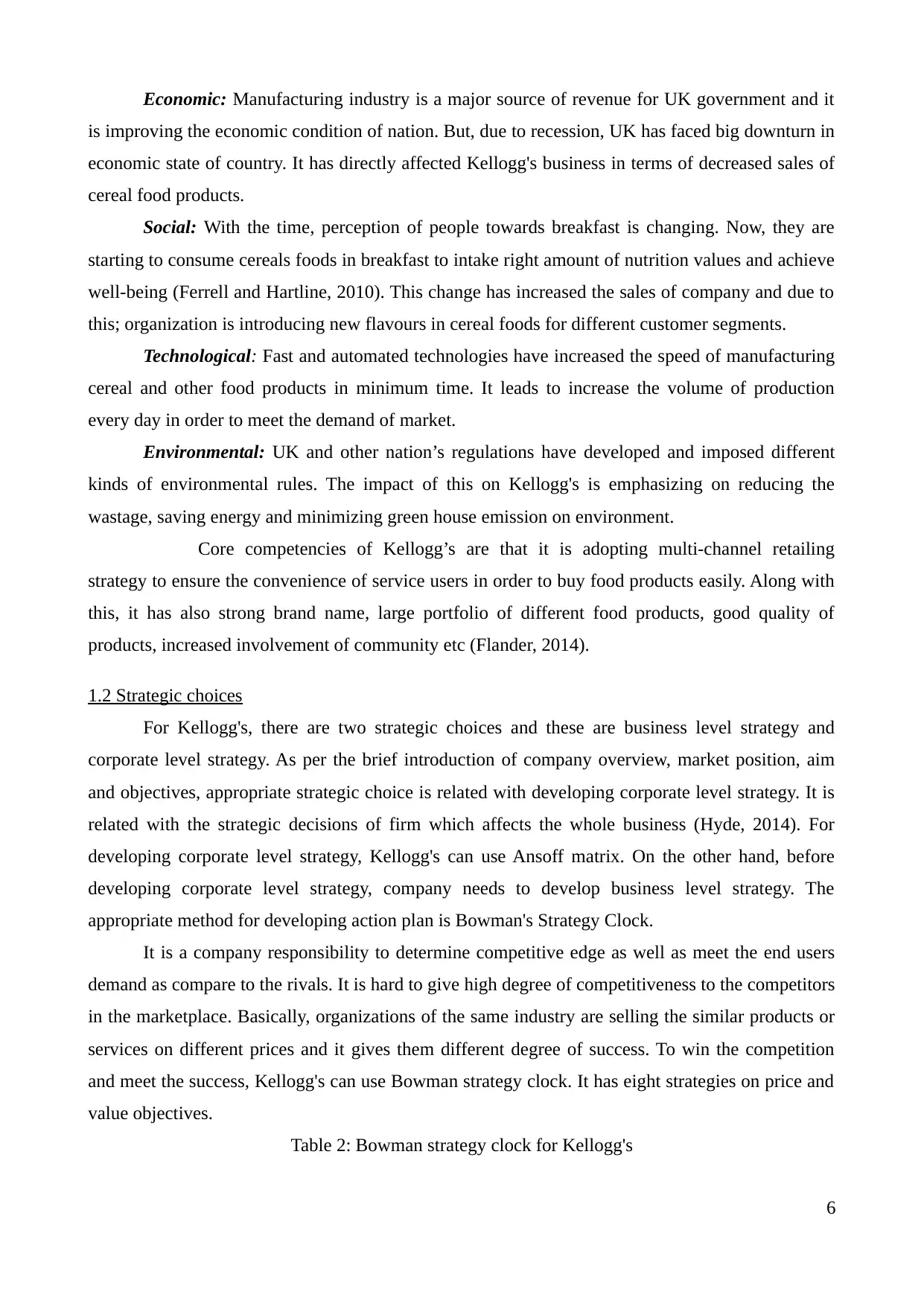
Economic: Manufacturing industry is a major source of revenue for UK government and it
is improving the economic condition of nation. But, due to recession, UK has faced big downturn in
economic state of country. It has directly affected Kellogg's business in terms of decreased sales of
cereal food products.
Social: With the time, perception of people towards breakfast is changing. Now, they are
starting to consume cereals foods in breakfast to intake right amount of nutrition values and achieve
well-being (Ferrell and Hartline, 2010). This change has increased the sales of company and due to
this; organization is introducing new flavours in cereal foods for different customer segments.
Technological: Fast and automated technologies have increased the speed of manufacturing
cereal and other food products in minimum time. It leads to increase the volume of production
every day in order to meet the demand of market.
Environmental: UK and other nation’s regulations have developed and imposed different
kinds of environmental rules. The impact of this on Kellogg's is emphasizing on reducing the
wastage, saving energy and minimizing green house emission on environment.
Core competencies of Kellogg’s are that it is adopting multi-channel retailing
strategy to ensure the convenience of service users in order to buy food products easily. Along with
this, it has also strong brand name, large portfolio of different food products, good quality of
products, increased involvement of community etc (Flander, 2014).
1.2 Strategic choices
For Kellogg's, there are two strategic choices and these are business level strategy and
corporate level strategy. As per the brief introduction of company overview, market position, aim
and objectives, appropriate strategic choice is related with developing corporate level strategy. It is
related with the strategic decisions of firm which affects the whole business (Hyde, 2014). For
developing corporate level strategy, Kellogg's can use Ansoff matrix. On the other hand, before
developing corporate level strategy, company needs to develop business level strategy. The
appropriate method for developing action plan is Bowman's Strategy Clock.
It is a company responsibility to determine competitive edge as well as meet the end users
demand as compare to the rivals. It is hard to give high degree of competitiveness to the competitors
in the marketplace. Basically, organizations of the same industry are selling the similar products or
services on different prices and it gives them different degree of success. To win the competition
and meet the success, Kellogg's can use Bowman strategy clock. It has eight strategies on price and
value objectives.
Table 2: Bowman strategy clock for Kellogg's
6
is improving the economic condition of nation. But, due to recession, UK has faced big downturn in
economic state of country. It has directly affected Kellogg's business in terms of decreased sales of
cereal food products.
Social: With the time, perception of people towards breakfast is changing. Now, they are
starting to consume cereals foods in breakfast to intake right amount of nutrition values and achieve
well-being (Ferrell and Hartline, 2010). This change has increased the sales of company and due to
this; organization is introducing new flavours in cereal foods for different customer segments.
Technological: Fast and automated technologies have increased the speed of manufacturing
cereal and other food products in minimum time. It leads to increase the volume of production
every day in order to meet the demand of market.
Environmental: UK and other nation’s regulations have developed and imposed different
kinds of environmental rules. The impact of this on Kellogg's is emphasizing on reducing the
wastage, saving energy and minimizing green house emission on environment.
Core competencies of Kellogg’s are that it is adopting multi-channel retailing
strategy to ensure the convenience of service users in order to buy food products easily. Along with
this, it has also strong brand name, large portfolio of different food products, good quality of
products, increased involvement of community etc (Flander, 2014).
1.2 Strategic choices
For Kellogg's, there are two strategic choices and these are business level strategy and
corporate level strategy. As per the brief introduction of company overview, market position, aim
and objectives, appropriate strategic choice is related with developing corporate level strategy. It is
related with the strategic decisions of firm which affects the whole business (Hyde, 2014). For
developing corporate level strategy, Kellogg's can use Ansoff matrix. On the other hand, before
developing corporate level strategy, company needs to develop business level strategy. The
appropriate method for developing action plan is Bowman's Strategy Clock.
It is a company responsibility to determine competitive edge as well as meet the end users
demand as compare to the rivals. It is hard to give high degree of competitiveness to the competitors
in the marketplace. Basically, organizations of the same industry are selling the similar products or
services on different prices and it gives them different degree of success. To win the competition
and meet the success, Kellogg's can use Bowman strategy clock. It has eight strategies on price and
value objectives.
Table 2: Bowman strategy clock for Kellogg's
6
⊘ This is a preview!⊘
Do you want full access?
Subscribe today to unlock all pages.

Trusted by 1+ million students worldwide
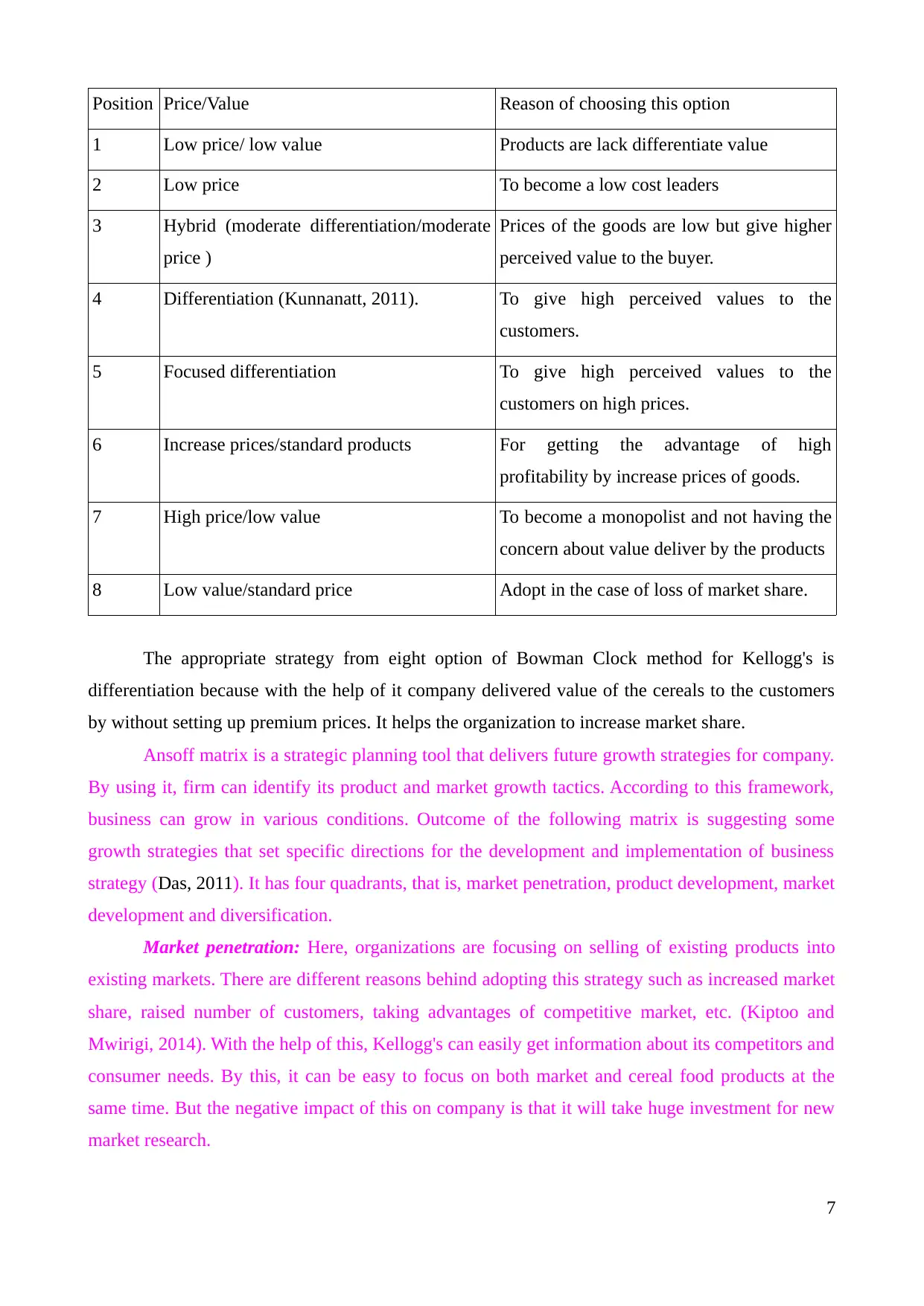
Position Price/Value Reason of choosing this option
1 Low price/ low value Products are lack differentiate value
2 Low price To become a low cost leaders
3 Hybrid (moderate differentiation/moderate
price )
Prices of the goods are low but give higher
perceived value to the buyer.
4 Differentiation (Kunnanatt, 2011). To give high perceived values to the
customers.
5 Focused differentiation To give high perceived values to the
customers on high prices.
6 Increase prices/standard products For getting the advantage of high
profitability by increase prices of goods.
7 High price/low value To become a monopolist and not having the
concern about value deliver by the products
8 Low value/standard price Adopt in the case of loss of market share.
The appropriate strategy from eight option of Bowman Clock method for Kellogg's is
differentiation because with the help of it company delivered value of the cereals to the customers
by without setting up premium prices. It helps the organization to increase market share.
Ansoff matrix is a strategic planning tool that delivers future growth strategies for company.
By using it, firm can identify its product and market growth tactics. According to this framework,
business can grow in various conditions. Outcome of the following matrix is suggesting some
growth strategies that set specific directions for the development and implementation of business
strategy (Das, 2011). It has four quadrants, that is, market penetration, product development, market
development and diversification.
Market penetration: Here, organizations are focusing on selling of existing products into
existing markets. There are different reasons behind adopting this strategy such as increased market
share, raised number of customers, taking advantages of competitive market, etc. (Kiptoo and
Mwirigi, 2014). With the help of this, Kellogg's can easily get information about its competitors and
consumer needs. By this, it can be easy to focus on both market and cereal food products at the
same time. But the negative impact of this on company is that it will take huge investment for new
market research.
7
1 Low price/ low value Products are lack differentiate value
2 Low price To become a low cost leaders
3 Hybrid (moderate differentiation/moderate
price )
Prices of the goods are low but give higher
perceived value to the buyer.
4 Differentiation (Kunnanatt, 2011). To give high perceived values to the
customers.
5 Focused differentiation To give high perceived values to the
customers on high prices.
6 Increase prices/standard products For getting the advantage of high
profitability by increase prices of goods.
7 High price/low value To become a monopolist and not having the
concern about value deliver by the products
8 Low value/standard price Adopt in the case of loss of market share.
The appropriate strategy from eight option of Bowman Clock method for Kellogg's is
differentiation because with the help of it company delivered value of the cereals to the customers
by without setting up premium prices. It helps the organization to increase market share.
Ansoff matrix is a strategic planning tool that delivers future growth strategies for company.
By using it, firm can identify its product and market growth tactics. According to this framework,
business can grow in various conditions. Outcome of the following matrix is suggesting some
growth strategies that set specific directions for the development and implementation of business
strategy (Das, 2011). It has four quadrants, that is, market penetration, product development, market
development and diversification.
Market penetration: Here, organizations are focusing on selling of existing products into
existing markets. There are different reasons behind adopting this strategy such as increased market
share, raised number of customers, taking advantages of competitive market, etc. (Kiptoo and
Mwirigi, 2014). With the help of this, Kellogg's can easily get information about its competitors and
consumer needs. By this, it can be easy to focus on both market and cereal food products at the
same time. But the negative impact of this on company is that it will take huge investment for new
market research.
7
Paraphrase This Document
Need a fresh take? Get an instant paraphrase of this document with our AI Paraphraser
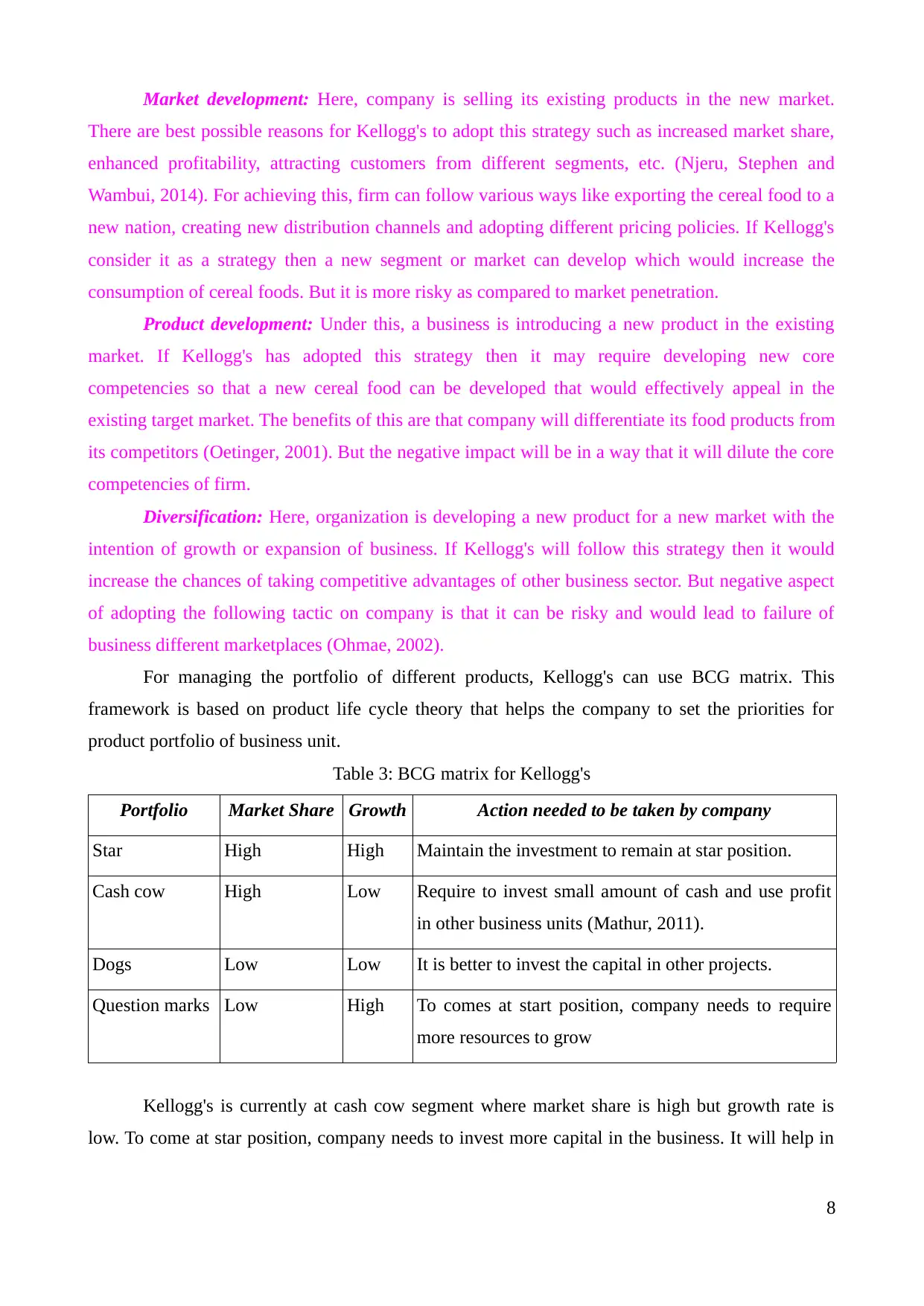
Market development: Here, company is selling its existing products in the new market.
There are best possible reasons for Kellogg's to adopt this strategy such as increased market share,
enhanced profitability, attracting customers from different segments, etc. (Njeru, Stephen and
Wambui, 2014). For achieving this, firm can follow various ways like exporting the cereal food to a
new nation, creating new distribution channels and adopting different pricing policies. If Kellogg's
consider it as a strategy then a new segment or market can develop which would increase the
consumption of cereal foods. But it is more risky as compared to market penetration.
Product development: Under this, a business is introducing a new product in the existing
market. If Kellogg's has adopted this strategy then it may require developing new core
competencies so that a new cereal food can be developed that would effectively appeal in the
existing target market. The benefits of this are that company will differentiate its food products from
its competitors (Oetinger, 2001). But the negative impact will be in a way that it will dilute the core
competencies of firm.
Diversification: Here, organization is developing a new product for a new market with the
intention of growth or expansion of business. If Kellogg's will follow this strategy then it would
increase the chances of taking competitive advantages of other business sector. But negative aspect
of adopting the following tactic on company is that it can be risky and would lead to failure of
business different marketplaces (Ohmae, 2002).
For managing the portfolio of different products, Kellogg's can use BCG matrix. This
framework is based on product life cycle theory that helps the company to set the priorities for
product portfolio of business unit.
Table 3: BCG matrix for Kellogg's
Portfolio Market Share Growth Action needed to be taken by company
Star High High Maintain the investment to remain at star position.
Cash cow High Low Require to invest small amount of cash and use profit
in other business units (Mathur, 2011).
Dogs Low Low It is better to invest the capital in other projects.
Question marks Low High To comes at start position, company needs to require
more resources to grow
Kellogg's is currently at cash cow segment where market share is high but growth rate is
low. To come at star position, company needs to invest more capital in the business. It will help in
8
There are best possible reasons for Kellogg's to adopt this strategy such as increased market share,
enhanced profitability, attracting customers from different segments, etc. (Njeru, Stephen and
Wambui, 2014). For achieving this, firm can follow various ways like exporting the cereal food to a
new nation, creating new distribution channels and adopting different pricing policies. If Kellogg's
consider it as a strategy then a new segment or market can develop which would increase the
consumption of cereal foods. But it is more risky as compared to market penetration.
Product development: Under this, a business is introducing a new product in the existing
market. If Kellogg's has adopted this strategy then it may require developing new core
competencies so that a new cereal food can be developed that would effectively appeal in the
existing target market. The benefits of this are that company will differentiate its food products from
its competitors (Oetinger, 2001). But the negative impact will be in a way that it will dilute the core
competencies of firm.
Diversification: Here, organization is developing a new product for a new market with the
intention of growth or expansion of business. If Kellogg's will follow this strategy then it would
increase the chances of taking competitive advantages of other business sector. But negative aspect
of adopting the following tactic on company is that it can be risky and would lead to failure of
business different marketplaces (Ohmae, 2002).
For managing the portfolio of different products, Kellogg's can use BCG matrix. This
framework is based on product life cycle theory that helps the company to set the priorities for
product portfolio of business unit.
Table 3: BCG matrix for Kellogg's
Portfolio Market Share Growth Action needed to be taken by company
Star High High Maintain the investment to remain at star position.
Cash cow High Low Require to invest small amount of cash and use profit
in other business units (Mathur, 2011).
Dogs Low Low It is better to invest the capital in other projects.
Question marks Low High To comes at start position, company needs to require
more resources to grow
Kellogg's is currently at cash cow segment where market share is high but growth rate is
low. To come at star position, company needs to invest more capital in the business. It will help in
8
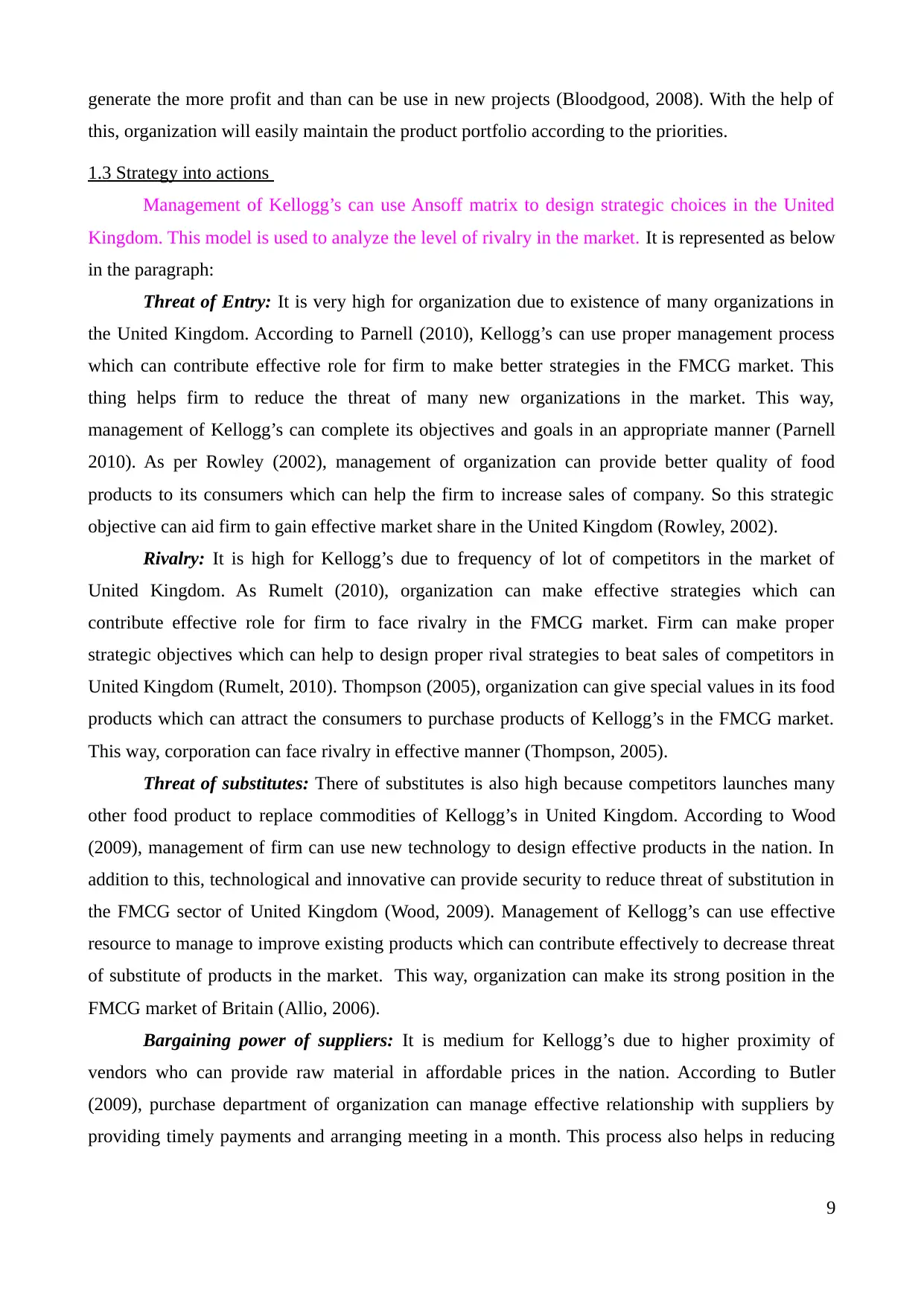
generate the more profit and than can be use in new projects (Bloodgood, 2008). With the help of
this, organization will easily maintain the product portfolio according to the priorities.
1.3 Strategy into actions
Management of Kellogg’s can use Ansoff matrix to design strategic choices in the United
Kingdom. This model is used to analyze the level of rivalry in the market. It is represented as below
in the paragraph:
Threat of Entry: It is very high for organization due to existence of many organizations in
the United Kingdom. According to Parnell (2010), Kellogg’s can use proper management process
which can contribute effective role for firm to make better strategies in the FMCG market. This
thing helps firm to reduce the threat of many new organizations in the market. This way,
management of Kellogg’s can complete its objectives and goals in an appropriate manner (Parnell
2010). As per Rowley (2002), management of organization can provide better quality of food
products to its consumers which can help the firm to increase sales of company. So this strategic
objective can aid firm to gain effective market share in the United Kingdom (Rowley, 2002).
Rivalry: It is high for Kellogg’s due to frequency of lot of competitors in the market of
United Kingdom. As Rumelt (2010), organization can make effective strategies which can
contribute effective role for firm to face rivalry in the FMCG market. Firm can make proper
strategic objectives which can help to design proper rival strategies to beat sales of competitors in
United Kingdom (Rumelt, 2010). Thompson (2005), organization can give special values in its food
products which can attract the consumers to purchase products of Kellogg’s in the FMCG market.
This way, corporation can face rivalry in effective manner (Thompson, 2005).
Threat of substitutes: There of substitutes is also high because competitors launches many
other food product to replace commodities of Kellogg’s in United Kingdom. According to Wood
(2009), management of firm can use new technology to design effective products in the nation. In
addition to this, technological and innovative can provide security to reduce threat of substitution in
the FMCG sector of United Kingdom (Wood, 2009). Management of Kellogg’s can use effective
resource to manage to improve existing products which can contribute effectively to decrease threat
of substitute of products in the market. This way, organization can make its strong position in the
FMCG market of Britain (Allio, 2006).
Bargaining power of suppliers: It is medium for Kellogg’s due to higher proximity of
vendors who can provide raw material in affordable prices in the nation. According to Butler
(2009), purchase department of organization can manage effective relationship with suppliers by
providing timely payments and arranging meeting in a month. This process also helps in reducing
9
this, organization will easily maintain the product portfolio according to the priorities.
1.3 Strategy into actions
Management of Kellogg’s can use Ansoff matrix to design strategic choices in the United
Kingdom. This model is used to analyze the level of rivalry in the market. It is represented as below
in the paragraph:
Threat of Entry: It is very high for organization due to existence of many organizations in
the United Kingdom. According to Parnell (2010), Kellogg’s can use proper management process
which can contribute effective role for firm to make better strategies in the FMCG market. This
thing helps firm to reduce the threat of many new organizations in the market. This way,
management of Kellogg’s can complete its objectives and goals in an appropriate manner (Parnell
2010). As per Rowley (2002), management of organization can provide better quality of food
products to its consumers which can help the firm to increase sales of company. So this strategic
objective can aid firm to gain effective market share in the United Kingdom (Rowley, 2002).
Rivalry: It is high for Kellogg’s due to frequency of lot of competitors in the market of
United Kingdom. As Rumelt (2010), organization can make effective strategies which can
contribute effective role for firm to face rivalry in the FMCG market. Firm can make proper
strategic objectives which can help to design proper rival strategies to beat sales of competitors in
United Kingdom (Rumelt, 2010). Thompson (2005), organization can give special values in its food
products which can attract the consumers to purchase products of Kellogg’s in the FMCG market.
This way, corporation can face rivalry in effective manner (Thompson, 2005).
Threat of substitutes: There of substitutes is also high because competitors launches many
other food product to replace commodities of Kellogg’s in United Kingdom. According to Wood
(2009), management of firm can use new technology to design effective products in the nation. In
addition to this, technological and innovative can provide security to reduce threat of substitution in
the FMCG sector of United Kingdom (Wood, 2009). Management of Kellogg’s can use effective
resource to manage to improve existing products which can contribute effectively to decrease threat
of substitute of products in the market. This way, organization can make its strong position in the
FMCG market of Britain (Allio, 2006).
Bargaining power of suppliers: It is medium for Kellogg’s due to higher proximity of
vendors who can provide raw material in affordable prices in the nation. According to Butler
(2009), purchase department of organization can manage effective relationship with suppliers by
providing timely payments and arranging meeting in a month. This process also helps in reducing
9
⊘ This is a preview!⊘
Do you want full access?
Subscribe today to unlock all pages.

Trusted by 1+ million students worldwide
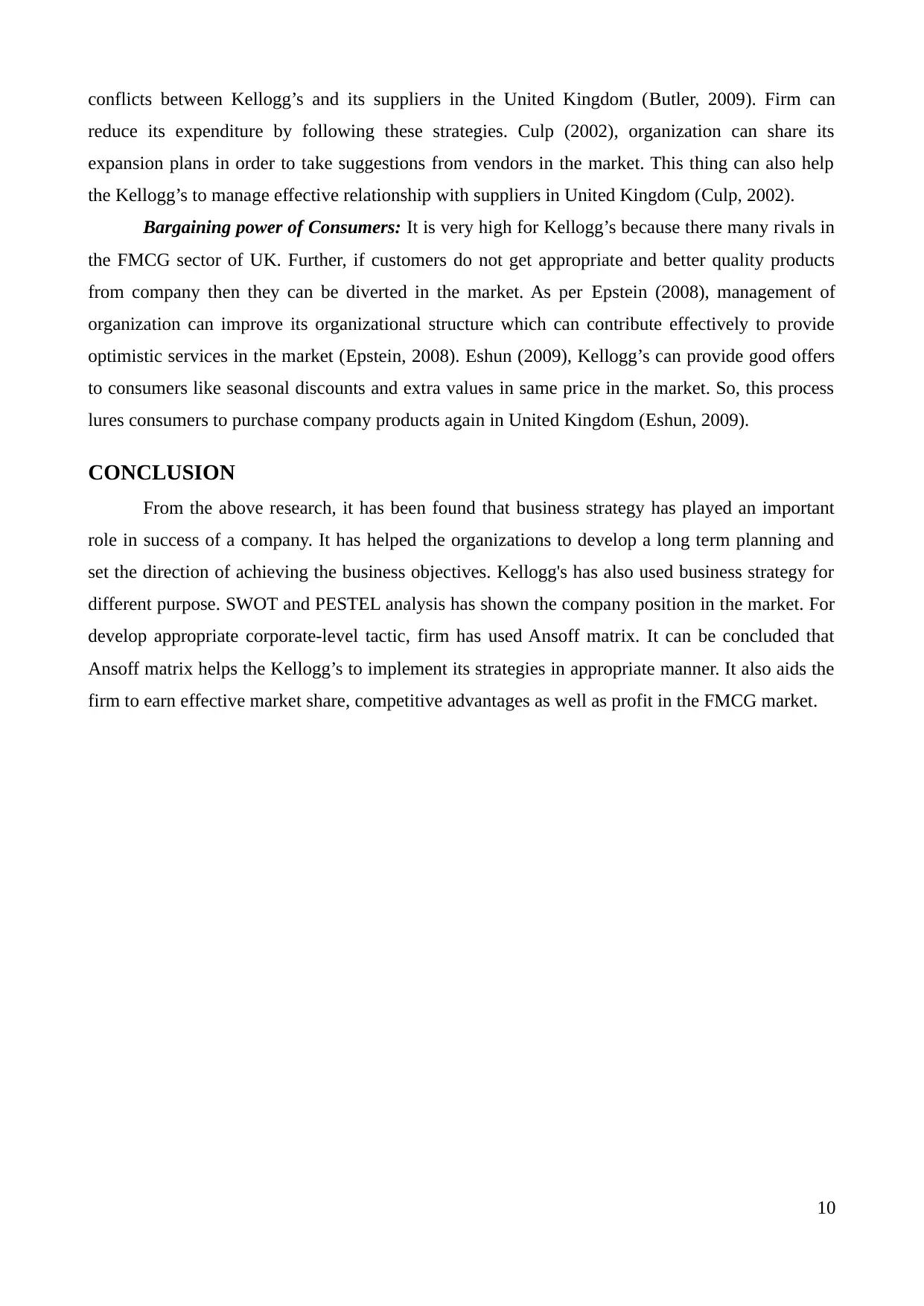
conflicts between Kellogg’s and its suppliers in the United Kingdom (Butler, 2009). Firm can
reduce its expenditure by following these strategies. Culp (2002), organization can share its
expansion plans in order to take suggestions from vendors in the market. This thing can also help
the Kellogg’s to manage effective relationship with suppliers in United Kingdom (Culp, 2002).
Bargaining power of Consumers: It is very high for Kellogg’s because there many rivals in
the FMCG sector of UK. Further, if customers do not get appropriate and better quality products
from company then they can be diverted in the market. As per Epstein (2008), management of
organization can improve its organizational structure which can contribute effectively to provide
optimistic services in the market (Epstein, 2008). Eshun (2009), Kellogg’s can provide good offers
to consumers like seasonal discounts and extra values in same price in the market. So, this process
lures consumers to purchase company products again in United Kingdom (Eshun, 2009).
CONCLUSION
From the above research, it has been found that business strategy has played an important
role in success of a company. It has helped the organizations to develop a long term planning and
set the direction of achieving the business objectives. Kellogg's has also used business strategy for
different purpose. SWOT and PESTEL analysis has shown the company position in the market. For
develop appropriate corporate-level tactic, firm has used Ansoff matrix. It can be concluded that
Ansoff matrix helps the Kellogg’s to implement its strategies in appropriate manner. It also aids the
firm to earn effective market share, competitive advantages as well as profit in the FMCG market.
10
reduce its expenditure by following these strategies. Culp (2002), organization can share its
expansion plans in order to take suggestions from vendors in the market. This thing can also help
the Kellogg’s to manage effective relationship with suppliers in United Kingdom (Culp, 2002).
Bargaining power of Consumers: It is very high for Kellogg’s because there many rivals in
the FMCG sector of UK. Further, if customers do not get appropriate and better quality products
from company then they can be diverted in the market. As per Epstein (2008), management of
organization can improve its organizational structure which can contribute effectively to provide
optimistic services in the market (Epstein, 2008). Eshun (2009), Kellogg’s can provide good offers
to consumers like seasonal discounts and extra values in same price in the market. So, this process
lures consumers to purchase company products again in United Kingdom (Eshun, 2009).
CONCLUSION
From the above research, it has been found that business strategy has played an important
role in success of a company. It has helped the organizations to develop a long term planning and
set the direction of achieving the business objectives. Kellogg's has also used business strategy for
different purpose. SWOT and PESTEL analysis has shown the company position in the market. For
develop appropriate corporate-level tactic, firm has used Ansoff matrix. It can be concluded that
Ansoff matrix helps the Kellogg’s to implement its strategies in appropriate manner. It also aids the
firm to earn effective market share, competitive advantages as well as profit in the FMCG market.
10
Paraphrase This Document
Need a fresh take? Get an instant paraphrase of this document with our AI Paraphraser
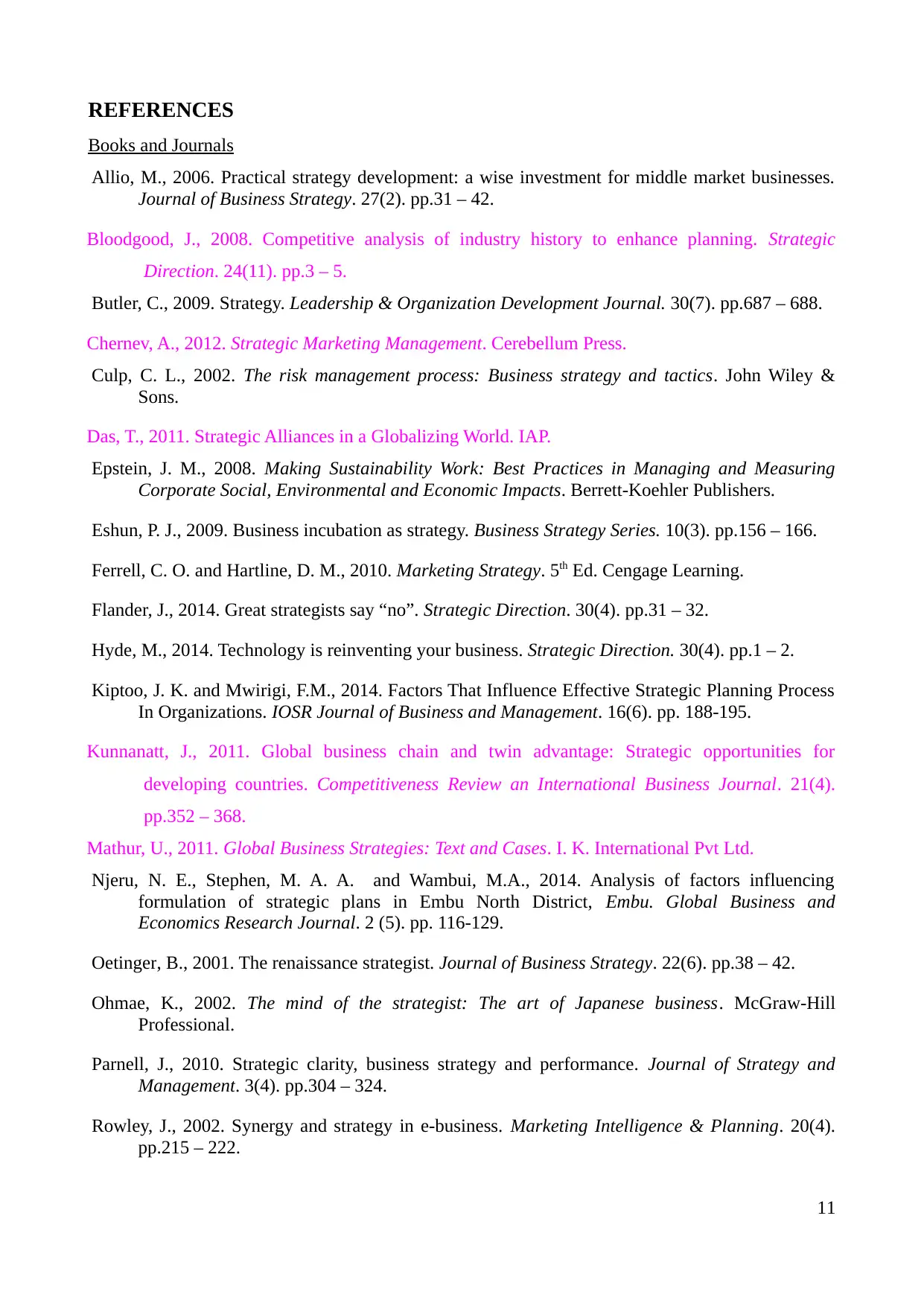
REFERENCES
Books and Journals
Allio, M., 2006. Practical strategy development: a wise investment for middle market businesses.
Journal of Business Strategy. 27(2). pp.31 – 42.
Bloodgood, J., 2008. Competitive analysis of industry history to enhance planning. Strategic
Direction. 24(11). pp.3 – 5.
Butler, C., 2009. Strategy. Leadership & Organization Development Journal. 30(7). pp.687 – 688.
Chernev, A., 2012. Strategic Marketing Management. Cerebellum Press.
Culp, C. L., 2002. The risk management process: Business strategy and tactics. John Wiley &
Sons.
Das, T., 2011. Strategic Alliances in a Globalizing World. IAP.
Epstein, J. M., 2008. Making Sustainability Work: Best Practices in Managing and Measuring
Corporate Social, Environmental and Economic Impacts. Berrett-Koehler Publishers.
Eshun, P. J., 2009. Business incubation as strategy. Business Strategy Series. 10(3). pp.156 – 166.
Ferrell, C. O. and Hartline, D. M., 2010. Marketing Strategy. 5th Ed. Cengage Learning.
Flander, J., 2014. Great strategists say “no”. Strategic Direction. 30(4). pp.31 – 32.
Hyde, M., 2014. Technology is reinventing your business. Strategic Direction. 30(4). pp.1 – 2.
Kiptoo, J. K. and Mwirigi, F.M., 2014. Factors That Influence Effective Strategic Planning Process
In Organizations. IOSR Journal of Business and Management. 16(6). pp. 188-195.
Kunnanatt, J., 2011. Global business chain and twin advantage: Strategic opportunities for
developing countries. Competitiveness Review an International Business Journal. 21(4).
pp.352 – 368.
Mathur, U., 2011. Global Business Strategies: Text and Cases. I. K. International Pvt Ltd.
Njeru, N. E., Stephen, M. A. A. and Wambui, M.A., 2014. Analysis of factors influencing
formulation of strategic plans in Embu North District, Embu. Global Business and
Economics Research Journal. 2 (5). pp. 116-129.
Oetinger, B., 2001. The renaissance strategist. Journal of Business Strategy. 22(6). pp.38 – 42.
Ohmae, K., 2002. The mind of the strategist: The art of Japanese business. McGraw-Hill
Professional.
Parnell, J., 2010. Strategic clarity, business strategy and performance. Journal of Strategy and
Management. 3(4). pp.304 – 324.
Rowley, J., 2002. Synergy and strategy in e‐business. Marketing Intelligence & Planning. 20(4).
pp.215 – 222.
11
Books and Journals
Allio, M., 2006. Practical strategy development: a wise investment for middle market businesses.
Journal of Business Strategy. 27(2). pp.31 – 42.
Bloodgood, J., 2008. Competitive analysis of industry history to enhance planning. Strategic
Direction. 24(11). pp.3 – 5.
Butler, C., 2009. Strategy. Leadership & Organization Development Journal. 30(7). pp.687 – 688.
Chernev, A., 2012. Strategic Marketing Management. Cerebellum Press.
Culp, C. L., 2002. The risk management process: Business strategy and tactics. John Wiley &
Sons.
Das, T., 2011. Strategic Alliances in a Globalizing World. IAP.
Epstein, J. M., 2008. Making Sustainability Work: Best Practices in Managing and Measuring
Corporate Social, Environmental and Economic Impacts. Berrett-Koehler Publishers.
Eshun, P. J., 2009. Business incubation as strategy. Business Strategy Series. 10(3). pp.156 – 166.
Ferrell, C. O. and Hartline, D. M., 2010. Marketing Strategy. 5th Ed. Cengage Learning.
Flander, J., 2014. Great strategists say “no”. Strategic Direction. 30(4). pp.31 – 32.
Hyde, M., 2014. Technology is reinventing your business. Strategic Direction. 30(4). pp.1 – 2.
Kiptoo, J. K. and Mwirigi, F.M., 2014. Factors That Influence Effective Strategic Planning Process
In Organizations. IOSR Journal of Business and Management. 16(6). pp. 188-195.
Kunnanatt, J., 2011. Global business chain and twin advantage: Strategic opportunities for
developing countries. Competitiveness Review an International Business Journal. 21(4).
pp.352 – 368.
Mathur, U., 2011. Global Business Strategies: Text and Cases. I. K. International Pvt Ltd.
Njeru, N. E., Stephen, M. A. A. and Wambui, M.A., 2014. Analysis of factors influencing
formulation of strategic plans in Embu North District, Embu. Global Business and
Economics Research Journal. 2 (5). pp. 116-129.
Oetinger, B., 2001. The renaissance strategist. Journal of Business Strategy. 22(6). pp.38 – 42.
Ohmae, K., 2002. The mind of the strategist: The art of Japanese business. McGraw-Hill
Professional.
Parnell, J., 2010. Strategic clarity, business strategy and performance. Journal of Strategy and
Management. 3(4). pp.304 – 324.
Rowley, J., 2002. Synergy and strategy in e‐business. Marketing Intelligence & Planning. 20(4).
pp.215 – 222.
11
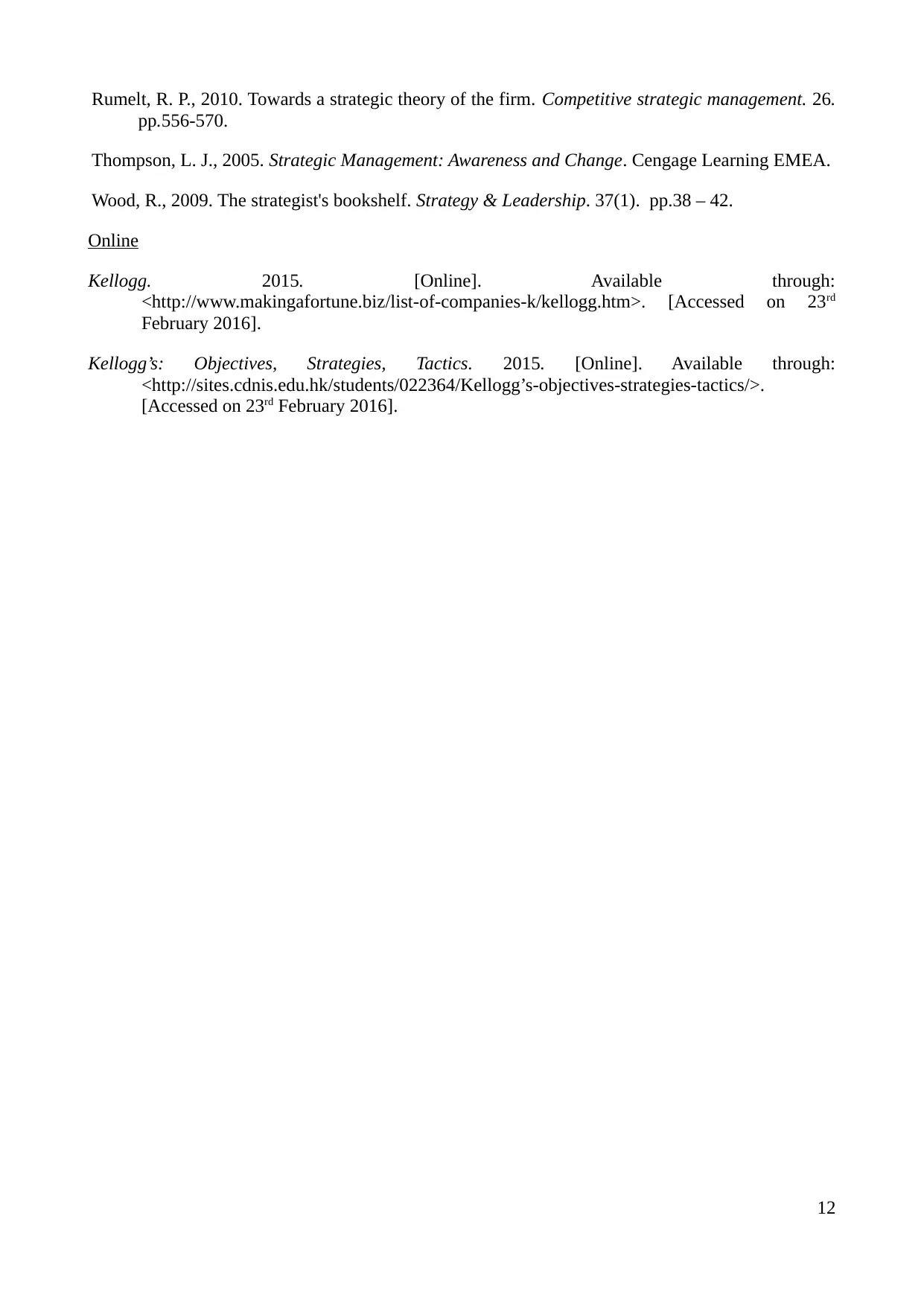
Rumelt, R. P., 2010. Towards a strategic theory of the firm. Competitive strategic management. 26.
pp.556-570.
Thompson, L. J., 2005. Strategic Management: Awareness and Change. Cengage Learning EMEA.
Wood, R., 2009. The strategist's bookshelf. Strategy & Leadership. 37(1). pp.38 – 42.
Online
Kellogg. 2015. [Online]. Available through:
<http://www.makingafortune.biz/list-of-companies-k/kellogg.htm>. [Accessed on 23rd
February 2016].
Kellogg’s: Objectives, Strategies, Tactics. 2015. [Online]. Available through:
<http://sites.cdnis.edu.hk/students/022364/Kellogg’s-objectives-strategies-tactics/>.
[Accessed on 23rd February 2016].
12
pp.556-570.
Thompson, L. J., 2005. Strategic Management: Awareness and Change. Cengage Learning EMEA.
Wood, R., 2009. The strategist's bookshelf. Strategy & Leadership. 37(1). pp.38 – 42.
Online
Kellogg. 2015. [Online]. Available through:
<http://www.makingafortune.biz/list-of-companies-k/kellogg.htm>. [Accessed on 23rd
February 2016].
Kellogg’s: Objectives, Strategies, Tactics. 2015. [Online]. Available through:
<http://sites.cdnis.edu.hk/students/022364/Kellogg’s-objectives-strategies-tactics/>.
[Accessed on 23rd February 2016].
12
⊘ This is a preview!⊘
Do you want full access?
Subscribe today to unlock all pages.

Trusted by 1+ million students worldwide
1 out of 12
Related Documents
Your All-in-One AI-Powered Toolkit for Academic Success.
+13062052269
info@desklib.com
Available 24*7 on WhatsApp / Email
![[object Object]](/_next/static/media/star-bottom.7253800d.svg)
Unlock your academic potential
Copyright © 2020–2025 A2Z Services. All Rights Reserved. Developed and managed by ZUCOL.





